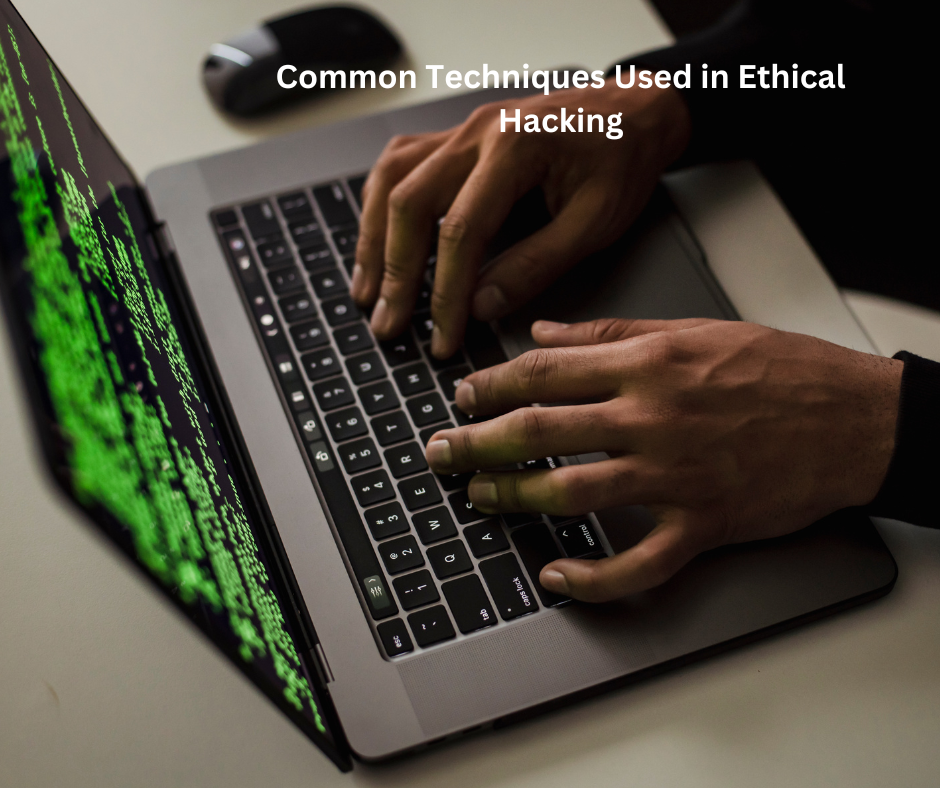Common Techniques Used in Ethical Hacking
 Ruhi Parveen
Ruhi Parveen
Ethical hacking, also known as penetration testing or white-hat hacking, is a crucial practice in cybersecurity. It involves testing and evaluating the security of a system, network, or application to identify vulnerabilities that could be exploited by malicious hackers. Unlike black-hat hackers, ethical hackers work with the permission of the system owner to enhance security. In this article, we'll explore some of the most common techniques used in ethical hacking.
1. Reconnaissance (Information Gathering)
Reconnaissance, also known as footprinting or information gathering, is the first phase of ethical hacking. In this stage, ethical hackers collect as much information as possible about the target system. This includes:
Passive Reconnaissance: Gathering information without directly interacting with the target involves collecting data through indirect methods. This can be done by searching public databases, social media, and other open sources.
Active Reconnaissance: Interacting directly with the target system to collect information. This may involve scanning the network, probing ports, and identifying services running on the system.
The goal of reconnaissance is to understand the target’s infrastructure and identify potential entry points for an attack.
2. Scanning and Enumeration
After gathering preliminary information, ethical hackers move on to scanning and enumeration. This phase involves identifying live hosts, open ports, and the services running on those ports. The tools and techniques used in this phase include:
Port Scanning: Identifying open ports on the target system using tools like Nmap or Netcat. Open ports can indicate potential vulnerabilities.
Vulnerability Scanning: Using automated tools like Nessus or OpenVAS to scan for known vulnerabilities in the target system.
Banner Grabbing: Capturing banners or messages sent by a service when connecting to it. This can reveal the software version and help in identifying vulnerabilities.
The information obtained during scanning and enumeration is crucial for planning the next steps in the penetration test.
3. Gaining Access
In this phase, ethical hackers attempt to exploit vulnerabilities identified during the scanning and enumeration phase to gain access to the target system. Some common techniques used to gain access include:
Exploitation: Using known vulnerabilities in software or hardware to gain unauthorized access. This could involve exploiting weaknesses in web applications, databases, or operating systems.
Password Attacks: Attempting to crack passwords using techniques such as brute force attacks, dictionary attacks, or rainbow tables.
Social Engineering: Manipulating individuals to divulge confidential information. Phishing is a common social engineering technique where attackers trick users into revealing their credentials.
Gaining access allows ethical hackers to move on to the next phase, where they can test the system's defenses and assess the impact of potential breaches.
4. Maintaining Access
Once access is gained, ethical hackers may attempt to maintain their presence on the system to carry out further exploitation or gather more information. This phase is known as maintaining access or persistence. Techniques used in this phase include:
Rootkits: Installing software that allows attackers to maintain control over the system without detection. Rootkits can hide processes, files, and network connections from the operating system.
Backdoors: Creating secret pathways into the system that allow attackers to re-enter even if the initial vulnerability is patched.
Privilege Escalation: Exploiting vulnerabilities to gain higher-level access within the system, such as administrator or root privileges.
Maintaining access is critical for ethical hackers to assess the extent to which an attacker could persist within a system undetected.
5. Covering Tracks
Ethical hackers also test how well they can hide their activities to evaluate the system's ability to detect and respond to breaches. Covering tracks is an essential phase in ethical hacking to mimic the actions of malicious hackers. Techniques used include:
Log File Manipulation: Deleting or altering log files to remove evidence of the attack.
Steganography: Hiding data within other files, such as embedding a malicious payload within an image or document.
Encryption: Encrypting data to prevent detection or tampering during transmission.
By covering tracks, ethical hackers can assess how difficult it would be for an organization to detect an ongoing attack and respond appropriately.
6. Reporting and Analysis
The final phase of ethical hacking is reporting and analysis. After completing the penetration test, ethical hackers compile a detailed report that outlines the findings, including vulnerabilities discovered, techniques used, and the potential impact of successful exploitation. The report typically includes:
Executive Summary: A high-level overview of the findings and recommendations for improving security.
Detailed Findings: A comprehensive account of each vulnerability discovered, including technical details and proof of concept.
Risk Assessment: An evaluation of the potential risks associated with the vulnerabilities, categorized by severity.
Recommendations: Suggestions for remediation and mitigation strategies to address the identified vulnerabilities.
The report is crucial for the organization to understand its security posture and take corrective actions to enhance its defenses.
Ethical Hacking Tools
Ethical hackers use a wide range of tools to carry out their work.
Nmap: A powerful network scanning tool used to discover hosts and services on a network.
Metasploit: A penetration testing framework that allows ethical hackers to exploit vulnerabilities and develop custom exploits.
Wireshark: A network protocol analyzer used to capture and inspect data packets transmitted over a network.
John the Ripper: A popular password-cracking tool used to test the strength of passwords.
Burp Suite: A comprehensive tool for testing the security of web applications, including features for scanning, crawling, and exploiting vulnerabilities.
These tools are essential for ethical hackers to perform thorough and effective penetration tests.
Legal and Ethical Considerations
Ethical hacking is bound by strict legal and ethical guidelines. Ethical hackers must always get clear permission from the system owner before performing any tests.They are required to:
Adhere to Scope: Only test the systems and networks within the agreed-upon scope.
Protect Data: Ensure that no sensitive data is exposed or compromised during testing.
Report Findings: Provide a detailed report of all findings, without withholding any information.
Failure to follow these guidelines can lead to legal consequences and damage the trust between the ethical hacker and the client.
Conclusion
Ethical hacking is a vital practice for organisations seeking to protect their systems from cyber threats. By using techniques such as reconnaissance, scanning, exploitation, and maintaining access, ethical hackers can identify vulnerabilities before malicious hackers exploit them. The insights gained from ethical hacking help organisations strengthen their security posture and reduce the risk of cyberattacks. For those interested in developing these crucial skills, Ethical Hacking Training in Noida, Delhi, Mumbai, Indore, and other parts of India provides comprehensive education and hands-on experience to prepare individuals for real-world challenges.
The role of an ethical hacker is both challenging and rewarding, requiring a deep understanding of cybersecurity, technical skills, and a strong commitment to ethical principles. As cyber threats continue to evolve, the demand for skilled ethical hackers will only grow, making it a valuable career path for those interested in safeguarding the digital world.
Subscribe to my newsletter
Read articles from Ruhi Parveen directly inside your inbox. Subscribe to the newsletter, and don't miss out.
Written by

Ruhi Parveen
Ruhi Parveen
I am a Digital Marketer and Content Marketing Specialist, I enjoy technical and non-technical writing. I enjoy learning something new.